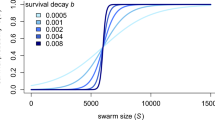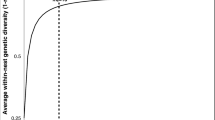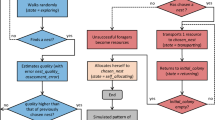Abstract
In most species of social insects, when a queen departs from her parental nest to found a new colony, she leaves on her own. In some species, however, the departing queen leaves accompanied by a portion of the parental colony’s workers and there is a permanent fissioning of the worker force. Little is known about how the adult workers in colonies of fissioning species distribute themselves between the old and the new colonies. We examined this problem, building on Bulmer’s (J Theor Biol 100: 329–339, 1983) model for the optimal splitting of a colony’s adult workforce during colony reproduction. We first created an inclusive fitness model of optimal colony fissioning that applies to species in which fissioning gives rise to two autonomous colonies. The model predicts the optimal “swarm fraction”, which we define as the proportion of the adult workers in a fissioning colony that join the departing queen. We then tested the model by comparing the predicted and observed swarm fractions in honey bees. We found a close match between predicted (0.76–0.77) and observed (0.72 ± 0.04) swarm fractions. Evidently, worker honey bees distribute themselves between the old and new colonies in a way that jointly maximizes the inclusive fitness of each worker. We conclude by discussing additional ways to test the model.


Similar content being viewed by others
References
Bulmer M.G. 1983. Sex ratio theory in social insects with swarming. J. Theor. Biol. 100: 329–339
Chéron B., Cronin A.L., Doums C., Fédérici P., Haussy C., Tirard C. and Monnin T. 2011. Unequal resource allocation among colonies produced by fission in the ant Cataglyphis cursor. Ecology 92:1448–1458
Cronin A.L., Fédérici P., Doums C. and Monnin T. 2012. The influence of intraspecific competition on resource allocation during dependent colony foundation in a social insect. Oecologia 168: 361–369
Cronin A.L., Molet M., Doums C., Monnin T. and Peeters C. 2013. Recurrent evolution of dependent colony foundation across social insects. Annu. Rev. Entomol. 58: 37–55
Crozier R.H. and Pamilo P. 1996. Evolution of Social Insect Colonies. Oxford University Press, Oxford
Denny A.J., Franks N.R., Powell S. and Edwards K.J. 2004. Exceptionally high levels of multiple mating in an army ant. Naturwissenschaften 91: 396–399
Estoup A., Solignac M. and Cornuet J.-M.1994. Precise assessment of the number of patrilines and of genetic relatedness in honeybee colonies. Proc. R. Soc. London B 258: 1–7
Fell R.D., Ambrose J.T., Burgett M., De Jong D., Morse R.A. and Seeley T.D. 1977. The seasonal cycle of swarming in honeybees. J. Apicult. Res. 16: 170–173
Getz W.M., Brückner D. and Parisian T.R. 1982. Kin structure and the swarming behavior of the honey bee Apis mellifera. Behav. Ecol. Sociobiol. 10: 265–270
Hirji K.F., Mehta C.R. and Patel N.R. 1987. Computing distributions for exact logistic regression. J. Am. Stat. Assoc. 82: 1110–1117
Hölldobler B. and Wilson E.O. 1990. The Ants. Harvard University Press, Cambridge, MA
Jeanne R.L.1991. The swarm-founding Polistinae. In: The Social Biology of Wasps (Ross K.G. and Matthews R.W., Eds), Cornell University Press, Ithaca, NY, pp 191–231
Kronauer D.J., Schöning C., Pedersen J.S., Boomsma J.J. and Gadau J.J. 2004. Extreme queen-mating frequency and colony fission in African army ants. Mol. Ecol. 13: 2381–2388
Kryger P. and Moritz R.F.A. 1997. Lack of kin recognition in swarming honeybees (Apis mellifera). Behav. Ecol. Sociobiol. 40: 271–276
Lee P.C. and Winston M.L. 1987. Effects of reproductive timing and colony size on the survival, offspring colony size and drone production in the honey bee (Apis mellifera). Ecol. Entomol. 12: 187–195
Lenoir A., Querard L., Pondicq N. and Berton F. 1988. Reproduction and dispersal in the ant Cataglyphis cursor (Hymenoptera, Formicidae). Psyche 95: 21–44
Martin P. 1963. Die Steuerung der Volksteilung beim Schwärmen der Bienen: zugleich ein Beitrag zum Problem der Wanderschwärme. Insect. Soc. 10: 13–42
Matsuura M. 1999. Size and composition of swarming colonies in Provespa anomala (Hymenoptera, Vespidae), a nocturnal social wasp. Insect. Soc. 46: 219–223
Mehta C.R. and Patel N.R. 1995. Exact logistic regression: theory and examples. Stat. Med. 14: 2143–2160
Morales G.S. 1986. Effects of cavity size on demography of unmanaged colonies of honey bees (Apis mellifera L.). M.Sc. Thesis, University of Guelph, Ontario
Pamilo P. 1991. Evolution of colony characteristics in social insects. I. Sex allocation. Am. Nat. 138: 83–107
Rangel J., Mattila H.R. and Seeley T.D. 2009. No intracolonial nepotism during colony fissioning in honey bees. Proc. R. Soc. London B 276: 3895–3900
Rangel J. and Seeley T.D. 2012. Colony fissioning in honey bees: size and significance of the swarm fraction. Insect. Soc. 59: 453–462
Roisin Y. and Pasteels J. 1986. Reproductive mechanisms in termites: polycalism and polygyny in Nasutitermes polygynes and N. costalis. Insect. Soc. 33: 149–167
Rosengren R. and Pamilo P. 1983. The evolution of polygyny and polydomy in mound-building Formica ants. Acta Entomol. Fenn. 42: 65–77
Roubik D.W. 1989. Ecology and Natural History of Tropical Bees. Cambridge University Press, New York, NY
Schneirla T.C. 1971. Army Ants: A Study in Social Organization. Freeman, San Francisco, CA
Seeley T.D. 1978. Life history strategy of the honey bee Apis mellifera. Oecologia 32: 109–118
Seeley T.D. 2010. Honeybee Democracy. Princeton University Press, Princeton, NJ
Seeley T.D. and Morse R.A. 1976. The nest of the honey bee (Apis mellifera). Insect. Soc. 23: 495–512
Seeley T.D. and Visscher P.K. 1985. Survival of honeybees in cold climates: the critical timing of colony growth and reproduction. Ecol. Entomol. 10: 81–88
Seeley T.D., Visscher P.K. and Passino K.M. 2006. Group decision making in honey bee swarms. Am. Sci. 94: 220–229
Smith A.R., O’Donnell S. and Jeanne R.L. 2002. Evolution of swarm communication in eusocial wasps (Hymenoptera: Vespidae). J. Insect Behav. 15: 751–764
Tarpy D.R. and Nielsen D.I. 2002. Sampling error, effective paternity, and estimating the genetic structure of honey bee colonies (Hymenoptera: Apidae). Ann. Entomol. Soc. Am. 95: 512–528
Visscher P.K. 2007. Group decision making in nest-site selection among social insects. Annu. Rev. Entomol. 52: 255–275
Winston M.L. 1987. The Biology of the Honey Bee. Harvard University Press, Cambridge, MA
Acknowledgments
We thank two anonymous reviewers for helpful comments that improved this manuscript, and Sean Griffin for helping collect data to determine the winter survival probabilities of mother-queen and sister-queen colonies. Funding was provided to J.R. by a US National Science Foundation Graduate Research Fellowship (Award number DGE 0707428), and by a State University of New York Graduate Underrepresented Minority Fellowship.
Author information
Authors and Affiliations
Corresponding author
Rights and permissions
About this article
Cite this article
Rangel, J., Reeve, H.K. & Seeley, T.D. Optimal colony fissioning in social insects: testing an inclusive fitness model with honey bees. Insect. Soc. 60, 445–452 (2013). https://doi.org/10.1007/s00040-013-0309-3
Received:
Revised:
Accepted:
Published:
Issue Date:
DOI: https://doi.org/10.1007/s00040-013-0309-3




